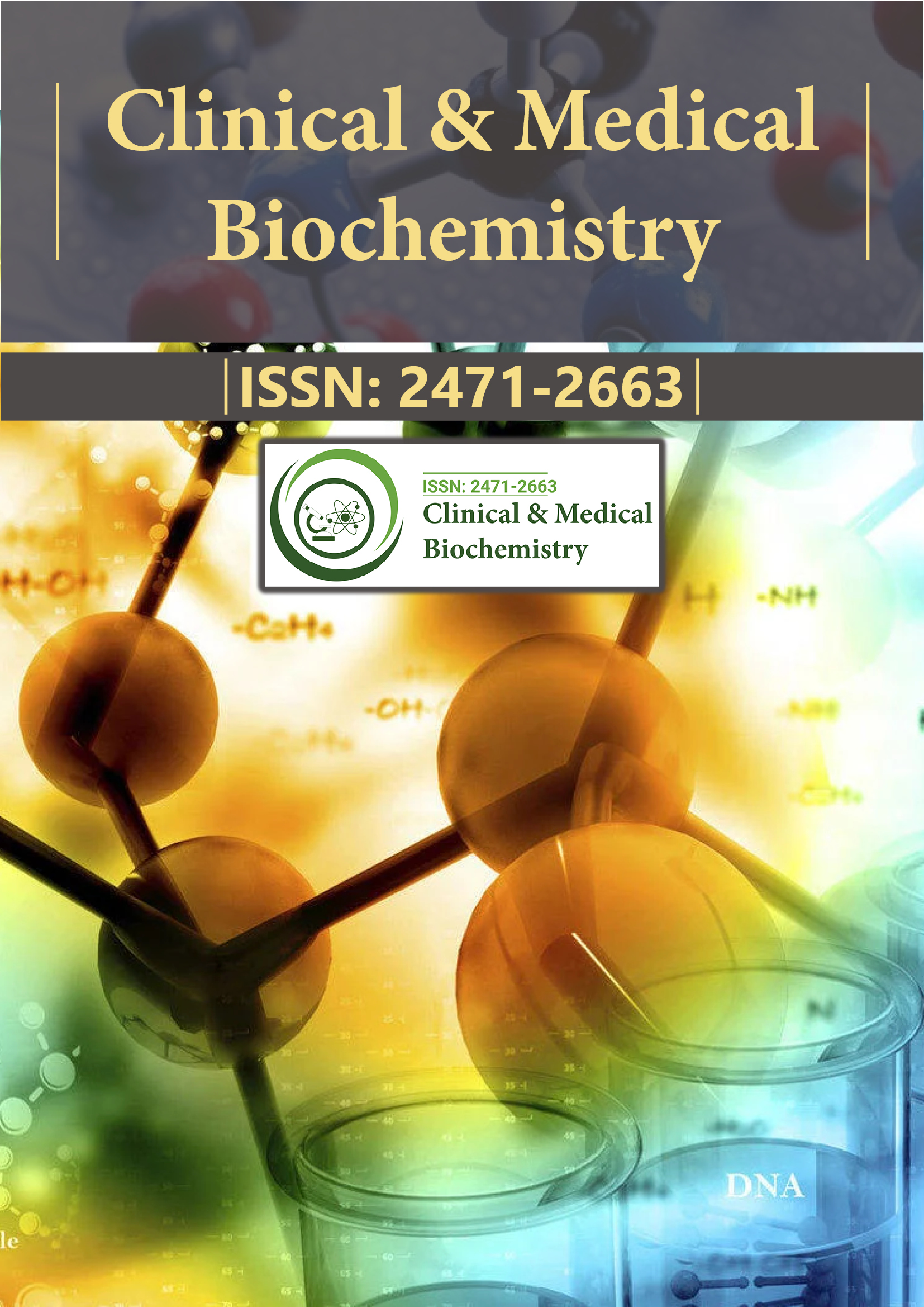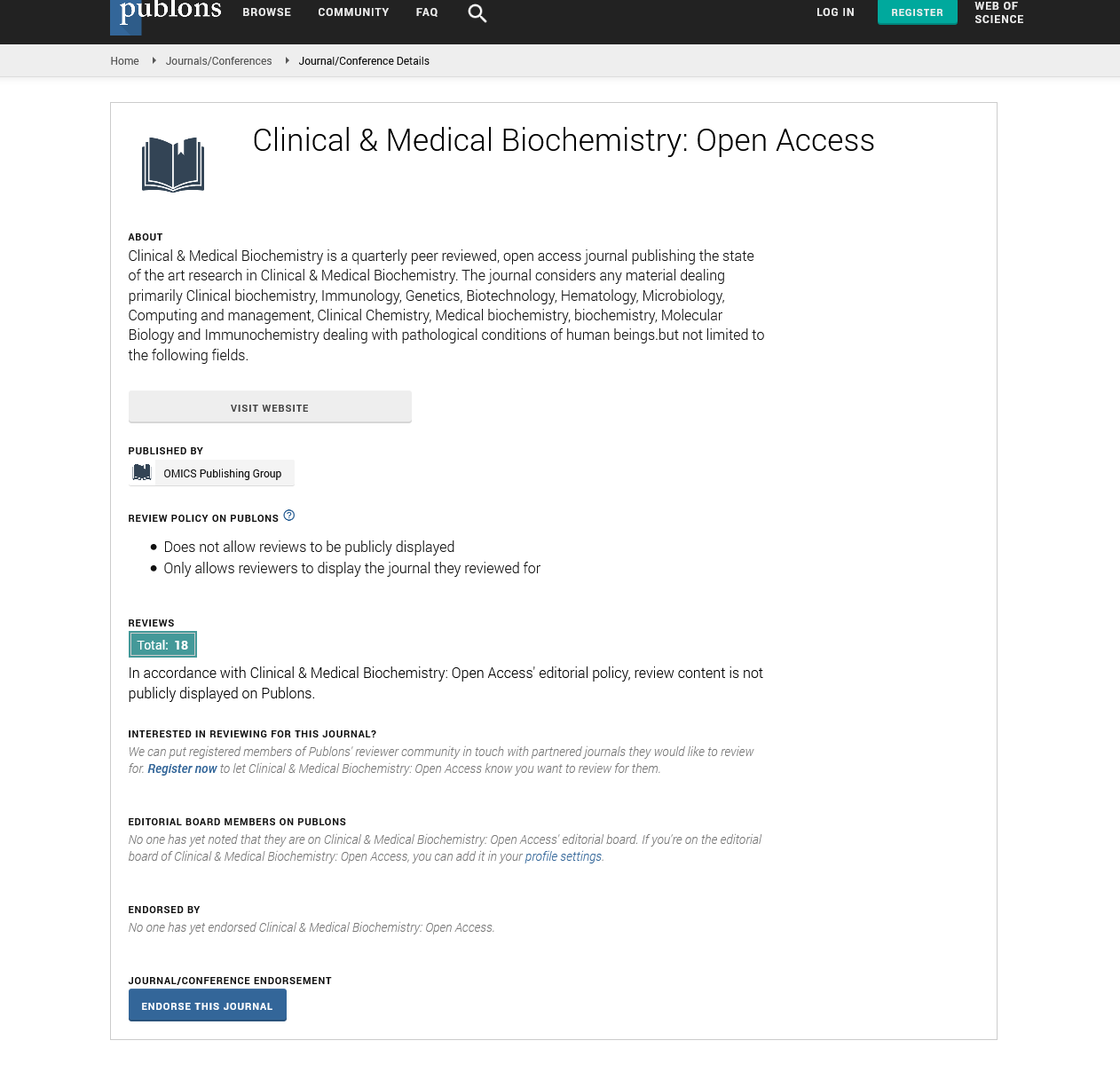Indexed In
- RefSeek
- Directory of Research Journal Indexing (DRJI)
- Hamdard University
- EBSCO A-Z
- OCLC- WorldCat
- Scholarsteer
- Publons
- Euro Pub
- Google Scholar
Useful Links
Share This Page
Journal Flyer

Open Access Journals
- Agri and Aquaculture
- Biochemistry
- Bioinformatics & Systems Biology
- Business & Management
- Chemistry
- Clinical Sciences
- Engineering
- Food & Nutrition
- General Science
- Genetics & Molecular Biology
- Immunology & Microbiology
- Medical Sciences
- Neuroscience & Psychology
- Nursing & Health Care
- Pharmaceutical Sciences
Commentry - (2024) Volume 10, Issue 4
Biochemical Analysis in Healthcare: Role of Clinical Chemistry in Disease Management
Peter Davison*Received: 25-Nov-2024, Manuscript No. CMBO-24-28348; Editor assigned: 27-Nov-2024, Pre QC No. CMBO-24-28348 (PQ); Reviewed: 12-Dec-2024, QC No. CMBO-24-28348; Revised: 20-Dec-2024, Manuscript No. CMBO-24-28348 (R); Published: 27-Dec-2024, DOI: 10.35841/2471-2663.24.10.235
Description
Clinical chemistry is a branch of laboratory medicine that plays an important role in modern healthcare. It involves the analysis of biological fluids such as blood, urine and cerebrospinal fluid to help diagnose, monitor and manage various medical conditions. This field has become an essential tool for healthcare professionals, as it provides valuable insights into the biochemical composition of the body and its changes in response to disease. By analyzing the concentrations of different substances, clinical chemistry assists in assessing the health of various organs and systems, allowing for accurate diagnosis and timely intervention.
One of the primary functions of clinical chemistry is to help physicians understand the underlying causes of a patient’s symptoms. Many diseases, such as diabetes, kidney disease, liver dysfunction and heart disease, can be diagnosed through the measurement of specific biomarkers present in blood and urine. For example, a blood glucose test is critical in the diagnosis and management of diabetes, while liver enzyme levels are monitored to assess liver health and detect liver diseases such as hepatitis or cirrhosis. Additionally, clinical chemistry tests can provide information on kidney function, electrolyte balance, protein levels and much more.
In addition to diagnostic purposes, clinical chemistry is also integral to monitoring the progress of diseases and evaluating the effectiveness of treatments. Regular testing can help assess how a patient’s body is responding to medication or therapy, allowing for adjustments when necessary. For example, monitoring the levels of cholesterol and triglycerides through lipid panels can help assess the effectiveness of a prescribed diet or lipid-lowering drugs. Similarly, cardiac biomarkers, such as troponin and brain natriuretic peptide, are measured to assess the severity of heart damage in patients with suspected heart attacks or heart failure.
Another significant role of clinical chemistry is in preventive healthcare. Many chronic conditions, including hypertension, diabetes and hyperlipidemia, can be detected early through routine laboratory tests. Early diagnosis allows for interventions that can slow disease progression or prevent complications. For example, by regularly monitoring kidney function through tests like serum creatinine and glomerular filtration rate, healthcare providers can detect kidney disease in its early stages and implement lifestyle changes or medication to slow its progression.
Clinical chemistry encompasses a broad range of tests that evaluate different aspects of health. Some of the most common tests include those that measure electrolytes, such as sodium, potassium and chloride, which are essential for maintaining proper fluid balance and muscle function. Imbalances in electrolytes can indicate dehydration, kidney dysfunction, or heart problems. Metabolic panels are used to assess kidney and liver function, blood glucose levels and overall metabolic health. Blood gas analysis is critical in evaluating lung function and acidbase balance, particularly in patients with respiratory or cardiac problems.
In conclusion, clinical chemistry plays an important role in modern medicine by providing information for diagnosing, monitoring and managing a wide range of diseases. It helps healthcare providers make informed decisions, improve patient care and enhance overall health outcomes. As technology continues to advance, the importance of clinical chemistry will only grow, making it an indispensable component of healthcare.
Citation: Davison P (2024). Biochemical Analysis in Healthcare: Role of Clinical Chemistry in Disease Management. Clin Med Bio Chem. 10:235.
Copyright: © 2024 Davison P. This is an open-access article distributed under the terms of the Creative Commons Attribution License, which permits unrestricted use, distribution, and reproduction in any medium, provided the original author and source are credited.

